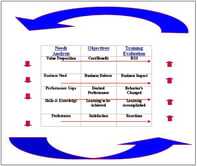Published on
Hurdles To Accurate Assessment Of Training Needs Within Organizations
- Training & OD professionals lack the business acumen, experience, or knowledge to accurately assess training needs
- Business leaders do not provide Training & OD departments the right resources , tools, or time to effectively assess training needs

When both are true within an organization, and I’ll argue one drives the other, alignment between organizational goals and learning strategy is impossible. I believe training departments that want to be accepted as business partners need to be proficient in several key competencies. If any of these are missing, accurate assessment of training needs becomes a daunting task.
Performance Consulting
At the heart of training needs assessment is performance consulting. As in the sales profession, a good questioning and probing strategy gets to the core of a prospective client’s needs so the appropriate product recommendation can be formulated within a business case. What are the products training departments sell internally? We recommend solutions that close gaps between actual and desired behavior and performance.
Performance consulting gives us the framework for utilize consulting skills internally to determine the root cause of client needs, whether it lead a training or non-training solution as the most appropriate.
Business Acumen
Effective performance consultants understand business. One of the biggest barriers to effective training needs assessment is a lack of understanding for how the organization prefers to do business. What does the company, department, or team value and why? Which key performance indicators (KPI) trump others with respect to the achievement of strategic goals? Is the cost/benefit analysis of a training recommendation in line with how the Chief Financial Officer might look at other capital investments?
Possessing business acumen is critical to speaking the language of business which in turn helps training professionals understand the key drivers that constitute true organizational training needs.
Fostering Collaboration
Defined as, to work, one with another, if a training department is unable to secure the cooperation of operations managers, collaboration does not happen. Instead, the training department is relegated to the role of order-taker and spends its time filling training requests that may or may not satisfy real training needs.
So we must answer the following question before proceeding. Why are operations managers unwilling to collaborate with training departments? The trainer may lack the business acumen and performance consulting skills necessary to be viewed as business partners.
If time is the investment management is asked to make in employee development, then the time invested must show a return in performance, productivity, behavioral change, or financial results. If not, it is unlikely that managers will make future investments or want to collaborate.
Negotiation and Influence
For the sake of this article, let’s consider negotiating and influencing one in the same. The mutual gains approach to negotiations teaches us that to arrive at agreement concessions may have to be made on both sides of the table. Asking management to invest time in employee development programs is the same as asking them to give up productive time. What concession will the training department make within the zone of possible agreement to arrive at a best alternative to a negotiated solution?
Coaching can be such a concession. A manger’s day is often filled with operational tasks, meetings, reporting, analysis and the like. Asking managers to carve out time for coaching and other one-on-one development activities will mean that other tasks may have to be sacrificed. Unless senior leaders agree, the likelihood of coaching as a function of a manager’s day-to-day is unlikely.
What if the training department agreed to provide coaching and one-on-one support services? This could be in the form of 30, 60, and 90 day post training to ensure knowledge and skills transfer to the job. It could also include coaching as a function of needs assessment to understand the day-to-day challenges faced by front line employees. Selfishly, it could be an activity that helps trainers gain business acumen and build relationships with managers that lead to better cooperation and collaboration.
Functional/Technical
Simply put, training professionals need to know how to conduct needs assessment. Regardless of whether a training department collaborates with the organizational development and human resource teams to analyze exit interview, employee engagement, and attrition trends as part of leadership development or if it is working directly with line management to identify operational, technical, or behavioral trends, trainers need to know what to look for and how to report their findings. Findings should be included in business cases and delivered to decision makers as formal proposals.
How can Training & OD departments begin to build the necessary and relevant internal partnerships that will drive deeper collaboration with business lines? The most successful learning leaders I know imbed their staff into specific operational areas. By spending time with the business unit, a trainer can begin to understand daily challenges, group norms, and barriers to achieving desired results, as well as best practices, to uncover training needs. The training department will also begin to develop the personal relationships necessary to either incubate a solution in a receptive pocket of the organization or garner support to create a business case. Ultimately, by uncovering accurate training needs, recommending and delivering programs that satisfy those needs, and reporting on the impact of training, credibility increases, leading to a real partnership between operations groups and training groups.
Author Perspective: Business



